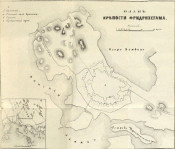
“Remarkable phenomenon in military history”: unknown pages of the Russian-Swedish war
There are events that can determine the course of time and development of all mankind... But these events, for some inexplicable accident, are kept in the background.
The Presidential Library provides a unique opportunity for its readers to focus on the circumstances of the Russian-Swedish war of 1741-1743, which took place in a very difficult time for our country - the era of palace coups and the accession of Empress Elizabeth Petrovna.
Users of the Presidential Library’s portal can get access to a digital copy of a truly rare book - “Description of the war between Russia and Sweden in Finland in 1741, 1742 and 1743” (1859). This work of N. S. Shpilevskaya is the result of a painstaking detailed study by the author of the Swedish archives. There are only few references to this confrontation: “The war in Finland of 1741, 1742 and 1743 represents a remarkable phenomenon in military history, but not with brilliant victories and remarkable military activities, but in another way. It is surprising that we still have almost nothing about it... I intend to collect here only some information that I have gathered mainly from Swedish sources, and I hope that they will not be without interest and benefit, since Swedish is little-known and everything written in this language regarding the Finnish war... is unknown”.
The Russian-Swedish war was conceived as a revenge. The political party of “hats” that came to power in Stockholm set a goal to return all the territories lost in the Northern War of 1700-1721. Therefore, the details of the attack on our state were worked out carefully for several years.
The publication notes that, in general, the Swedes were afraid to raise weapons to the Russian Empire - many still remembered its strength, the brilliant genius of Peter I and the surrender of his king Charles XII. Therefore, new Swedish authorities primarily decided to hold a powerful campaign. It succeeded.
In her book, N. S. Shpilevskaya tells: as soon as the Swedish king Frederick I realized that hatred of Russia among his subjects had culminated, he announced full-scale preparations for the offensive.
For the time being, the Swedes limited themselves to excuses and fictitious pretexts - it was important for Stockholm to gain time and lull the vigilance of Russia. Meanwhile, “by a secret commission it was determined that if certain circumstances favorable for the purposes of Sweden came, the army and navy should be put into martial law with all possible haste and secret, so that military activities could be launched at the first need”.
In July 1741, King Frederick, confident in the success of his army and navy, declared war. The reasons for such actions seemed far-fetched - for example, Russia's intervention in the internal affairs of Sweden... The troops turned against us located in Finland were given a special monarchial decree.
However, it was impossible to catch our country by surprise. Watching the preparations of the Swedish military commander Charles Lewenhaupt, our commander Peter Lacy took all necessary measures to repel the enemy’s blow and the subsequent counterattack.
It should be emphasized that the path of the Russian Empire in this war almost immediately began with victories. As a result of one of the main battles - for the Villmanstrand fortress - the enemy was routed. For the people of Lewenhaupt, who were initially confident of a favorable outcome, this was a serious blow: panic began to flourish even then... N. S. Shpilevskaya managed to find and translate the memories of one of the participants in the war, Swedish pastor Tiburtsius: “It was one of the saddest days for Sweden, because on that day it lost the battle of Villmanstrand as well as the fortress of the same name”.
The party of “hats”, which launched the campaign, realized the destructive recklessness in the decision to fight with Russia. But an immediate retreat meant the inevitable collapse of Sweden’s political elite. A temporary salvation was the change of power from the enemy: Elizabeth Petrovna ascended the throne of the Russian Empire, with whom a truce was concluded. However neither King Frederick I, nor his advisers, probably in confusion, took into account that now they have to deal with the daughter of Peter the Great, who crushed Sweden...
Very soon, the ceasefire was broken, and Field Marshal Lacy, by order of Elizabeth, began to oppress the enemy. The second truly terrible defeat the Swedes suffered in 1742 at Fredrikshamn. They fled, putting the stronghold on fire... Father Tiburtsius testifies that his compatriots literally went crazy with fear, only hearing about the Russians.
After the fall of Fredrikshamn, it became completely clear: Stockholm capitulates, and when - it is only a matter of time. 1743 (and the last) year of the Russian-Swedish war was covered with the glory of the victory of our fleet at the island of Korpo. The only thing the enemy was still sure of was his ships, their powerful armaments and an advantageous position at sea. But the Russian galleys and prams - the battery ships - were invincible.
The signing of the inevitable peace for Stockholm took place on August 18, 1743. Peace, which meant defeat for people such as Charles Lewenhaupt and His Majesty Frederick I. Under the terms of the treaty, Sweden renounced all its claims to Russian territory once and for all. And Elizabeth Petrovna thus proved her right to ascend the throne.

